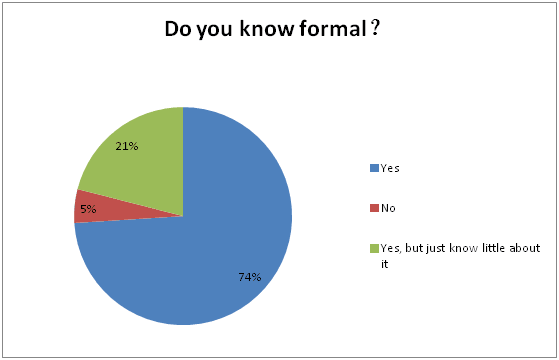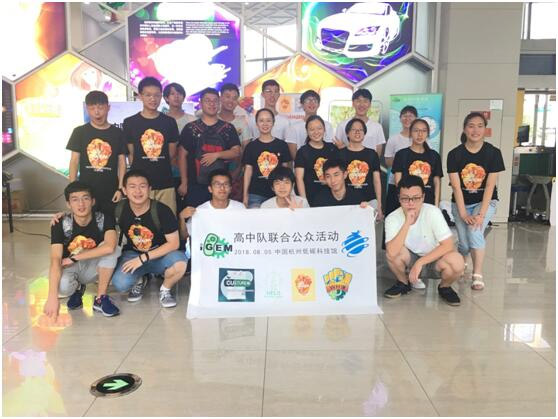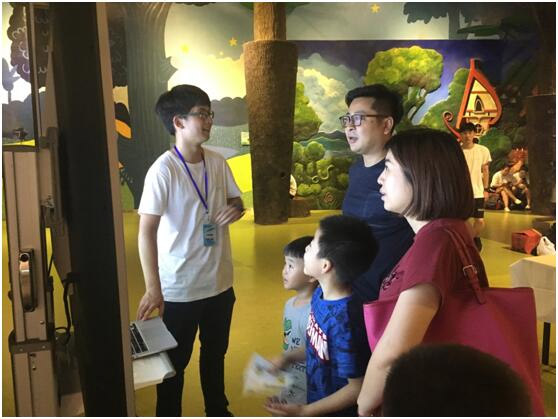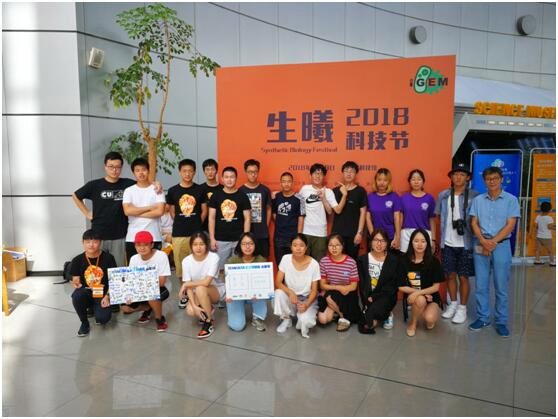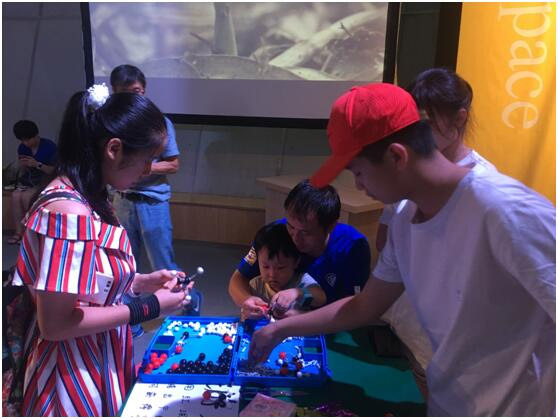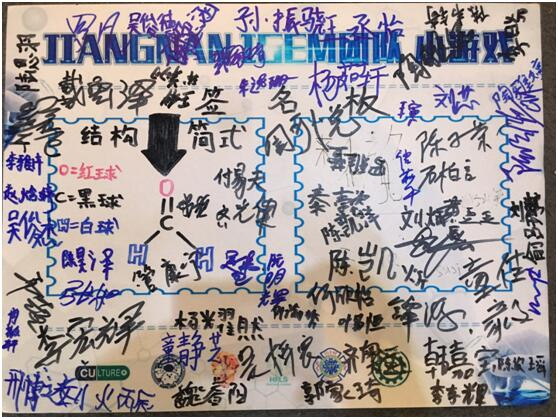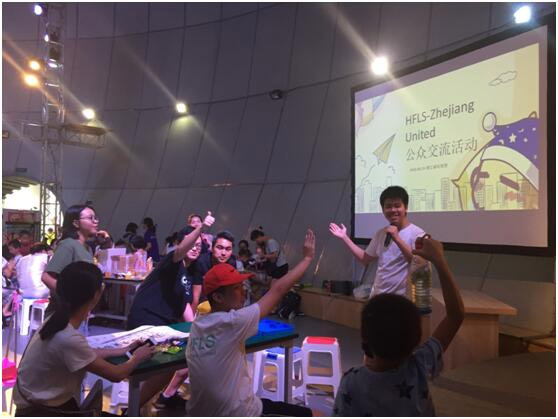What's the meaning of our project? From the beginning of the IGEM preparation, we struggled to find the answer. The purpose of science is permanent -- bringing benefits to human society. Thus, we conducted our human practices, including the survey and 2 promotion campaigns in the science museum, to seek the social impact we could create. China is a special country, different from traditional developed countries, such as America, British, and France and also different from normal developing countries, such as South Africa and Brazil. China contains the largest population base which is over 1.3 billion people, so, many social issues have their traits, so-called Chinese characteristics. We conducted a deep survey considering formaldehyde, a popular and unique social issue in China. When it came to the diversity of samples, we adopted both an online survey and traditional survey using papers, which finally got a satisfactory result. Q1: Do you know formal? In the first question, we wonder that how well do citizens know about formaldehyde. Surprisingly, 74 percent of people claim that they have known about formaldehyde, and only 5 percent of people know nothing about it. The data proves our previous thought that formaldehyde is an especially popular social issue in China, so it should have an important social meaning and breadth. We believe that if this issue can be solved, there will be a large social impact on the majority of Chinese. Q2: How well do you know about formaldehyde? It has mentioned in the first question that 74 percent of people have known about formaldehyde, and this result has also been supported by the second questions. It shows that 77 percent of people have more or less understanding about formaldehyde, knowing its basic knowledge. We also have to pay attention to the statistic that only 0.5 percent of people have professional research on formaldehyde, illustrating that formaldehyde is an abstruse question in the general public. Although they know some fundamental properties upon this issue, lacking its deeper understanding causes wrong judgments when encountering high formaldehyde concentration. The data of this part strengthened our desire to organize human practice to popularize useful knowledge about formaldehyde. Q3: Would you pay attention to the concentration of formaldehyde in our daily life? This question exposes the severity of the formaldehyde social issue. It presents that although majority know formaldehyde is kind of material that could cause cancer and other serious diseases, they choose to ignore it in the daily life. Over half of people suggest that they will test formaldehyde concentration only if they feel uncomfortable about it, which could miss the best treatment time and even can lead to death. Those 26 percent of people who never care about formaldehyde would take an even bigger risk of the serious effects. Considering the low awareness of excessive formaldehyde concentration, we feel anxious about the attitude showed by the general public when we are collecting the data. So we want to focus more on the right measures that prevent people from formaldehyde poisoning. Besides, we are curious that if we could invent an easier way to test the formaldehyde concentration in the room to avoid serious result caused by people's unawareness. Q4: Decoration in a new house would generate formaldehyde, so how would you judge when to move in? In this question, we want to know more about ways people are currently using for formaldehyde concentration checking. Because is a multiple-choices question, we choose the three highest options to analyze: Keeping the house empty for a year, using active carbon or other physical methods, and using plants to absorb toxic gas. Noticeably, most the people would not choose to invite an expert to test it. Instead, they use ways to decompose formaldehyde based on their own life experience, which lacks the scientific evidence to certify whether the concentration reach the standard. So we could infer that people's solutions are not only appropriate, but also irresponsible for themselves and other people live in the house. At the same time, we know that we should provide an easier way in order to make it accessible to citizens. Our project contains the detection of formaldehyde and the degradation of formaldehyde. The following three questions confirm our intention to use synthetic biology to solve formaldehyde issue. Q5: Do you think current technology could solve the formaldehyde issue? The fifth question reveals the general understanding of formaldehyde degradation. For 38 percent of people, because their careers are not related to this issue, they would not pay attention to the scientific improvement in this field. Thus, our research and activity have a significant social impact on their basic understanding within this field, which could largely reduce death rate caused by formaldehyde. For 50 percent of the people who believe such technology can efficiently solve the question of formaldehyde, they are possibly students or some white-collars who have their own evaluation and attitude toward the technology development. They can better accept the concept of synthetic biology and may have the deeper comprehension of our project. In a business perspective, people who can understand the principles of formaldehyde degradation correspondingly will be easier convinced by our theory, which means that at least 50 percent of the people will be our potential "customers". Q6: Suppose today's technology could solve the problem, which one do you think is the most efficient? In the sixth question, we found that all other three choices share nearly equal rate except the choice “use special material to sealing the formaldehyde”, which matches three methods of solutions: physical method, chemical method, and biological method. Among the three methods, the one with highest pick rate is using a transgenic plant with the ability to absorb formaldehyde, matching with the biological method. People probably give this conclusion because of their daily experience, believing certain genetic period responsible for formaldehyde absorption, which conforms to science logistics. Also, the low pick rate option “use a special material for sealing the formaldehyde” indicates that people refuse the incomplete decompose of formaldehyde. The finding gives us an important indication of the direction of research, which would base on the ultimate complete degradation of formaldehyde. Q7: If the methods above could solve the problem, but have some shortcomings, which one would you choose? Our project contains the detection of formaldehyde and the degradation of formaldehyde. The following three questions confirm our intention to use synthetic biology to solve formaldehyde issue. The fifth question reveals the general understanding of formaldehyde degradation. For 38 percent of people, because their careers are not related to this issue, they would not pay attention to the scientific improvement in this field. Thus, our research and activity have a significant social impact on their basic understanding within this field, which could largely reduce death rate caused by formaldehyde. For 50 percent of the people who believe such technology can efficiently solve the question of formaldehyde, they are possibly students or some white-collars who have their own evaluation and attitude toward the technology development. They can better accept the concept of synthetic biology and may have the deeper comprehension of our project. In a business perspective, people who can understand the principles of formaldehyde degradation correspondingly will be easier convinced by our theory, which means that at least 50 percent of the people will be our potential "customers". In the sixth question, we found that all other three choices share nearly equal rate except the choice “use special material to sealing the formaldehyde”, which matches three methods of solutions: physical method, chemical method, and biological method. Among the three methods, the one with highest pick rate is using a transgenic plant with ability to absorb formaldehyde, matching with the biological method. People probably give this conclusion because of their daily experience, believing certain genetic period responsible for formaldehyde absorption, which conform to science logistics. Also, the low pick rate option “use a special material for sealing the formaldehyde” indicates that people refuse the incomplete decompose of formaldehyde. The finding gives us an important indication of the direction of research, which would base on the ultimate complete degradation of formaldehyde. The seventh question is the analysis of the pros and cons of the four choices given in the sixth question. We list advantage and the potential risks of every method objectively, which could let people to make their own judgment. We can see from the graph that after listing the advantages and disadvantages, the difference between physical, chemical, and biological method become bigger, up to 15 percent, which proves people’s support to the biological method. But Chinese fear of transgenic objects is the difficulty we are facing in the project. However, through the analysis of the research statistics, we found that people’s opposition to transgenic is not as apparent as the concern of incomplete decomposition of formaldehyde; this makes us more confident at exploring the project further. Q8: Where do you get the information about formaldehyde? The last question focuses on the HP lecture. Knowing how people learn the knowledge can help us better estimate people’s mastery of the knowledge in formaldehyde decomposition, which can facilitate the process of popularization of science.
Survey conclusion Using the term of research in the early phase of the project is an effective way. It not only provides the instruction for our research direction, but also rises our awareness of the gravity of formaldehyde issue, which motivate us to do something for the whole society. Moreover, this survey also serves as a good vehicle to the preparation of two human practices conducted in science museum later.
First promotion campaign
On August 5th, our team held the human practice in Low carbon science and technology museum in Hangzhou to spread knowledge of synthetic biology to kids. There are 3 sessions within the activity, including DNA extracting experiment, game session, Q&A session. Children had to begin with the first session, and only those who finished the whole adventure could receive presents.
Picture1: The group photo with organizers from 3 IGEM teams
Though the activity only lasted for one day, our group members really worked hard in order to prepare the activity. We made a great success both in this human practice and the collaboration with other teams.
Picture 2: Our team member is introducing our projects to those parents.
Although the preparation was really challenging for high school students to achieve, we were enthusiastic about every difficulties we met, and gained precious experience within the process, making us more mature and stronger in organizing ability. Also, the failure of this activity had been thoroughly improved in the next human practice.
Second promotion campaign
Our team members have organized 2018 Shengxi Science Day with Zhejiang Science Museum, Zhejiang Science & technology organization, AST Space, ZJU-IGEM, Jiangnan, ZJUT-IGEM, ASTWS-China, and WorldShaper-XSHS.
Picture 3: The group photo of all organizers from 6 IGEM teams
Organizing:
During the preparing time, our team showed great enthusiasm about organizing and making plans, helping other 5 teams to finish the preparation together. Since it was the second time of our human practice, we had more experience over other college teams. Minghao Zhou gave the revision of the PPT based on the previous one, which made it more acceptable for children in a young age. The language using in the PPT was changed into informal one, causing better understandings for those kids toward our topics of formaldehyde's harmfulness. In the process, comics from Tianlun Yu were the most important part. Many young audiences could not understand our content, because they are just elementary students who knew exactly nothing about synthetic biology. Using comics is quite innovative educational method that could help kids to comprehend the professional knowledge.
Picture 4: The comics designed by Tianlun Yu to illustrate our project
When it came to the game, Jiayue Wu gave a lot of suggestions as the leader of our team. She proposed that although complex games could help students to learn more knowledge, fewer students would participate in the game. So if we simplify the game into an easier one, we could have a larger impact among participants in this activity. The new game would also help those children to understand the damage of formaldehyde and the value of our project.
Game part:
In IGEM, our team's project is mainly about the decomposition and detection of formaldehyde, leading to the principle of our game. Given the structural formula of formaldehyde, Children would make the ball-and-stick model of formaldehyde by themselves. This game is easy for small kids to play, testing the ability of observation and inspiring their interests upon biology and chemistry. After the competition, they had remembered not only what formaldehyde is, but also its structural formula and ball-and-stick model. Of course, many parents also showed great passion in the game.
Picture 5: A farther is teaching his son how to build the ball-and-stick model for formaldehyde
See?! Everyone was concentrating on our game! Moreover, we offer the signature board to propagate our project to all people who had been engaged in the game. They all signed on the board to show their support to our program.
Picture 6: if people appreciate our program they could sign on our board to express their support.
Presentation & interaction
Minghao Zhou and Yineng Chen take responsibility on the speech and question time. At the beginning of the speech, different from other five teams, we stressed the importance of participation of children themselves and illustrated the rules of quiz part that any parents would not be allowed to help their children. This strategy successfully drew those children's attention and let their parents know the meaning of popular science part. Minghao Zhou delivered the information about formaldehyde existence and effects of over criteria. Then, Yineng Chen helped kids to learn the knowledge in the comics, playing a role of the instructor in the comics, which aimed to help those children to have a deeper understanding. In order to test the achievement of the speech, we used the special answering pattern. Student who raised his hand fastest could have the opportunity to answer the question. Surprisingly, we are shocked by their ability of accepting professional knowledge. Those young children could raise their hands even without second consideration. Some questions even reached a level of high school knowledge, which must be extremely difficult for kids under 10-year-old to solve. However, everyone seemed to be confident about their answers, and finally solved all the questions we prepared.
Picture7: Our team member is giving the speech to the general public
The patience and enthusiasm of those small kids totally exceeds our imagination. After the speech, several parents consulted me about our team and IGEM. We explained their confusion patiently and were happy to see their advancement. The most impressive one was a mom of a elementary school student. She told us that his son was really interested in synthetic biology and our group project through this activity. She wondered how we were able to organize such a big activity independently. We told her about the challenges we met and she really appreciated the fruit we got through our own efforts.
Summary
After these 3 popular science activities, we realize something we haven't thought before. Actually, our values are contained in all the things we have done during our way of IGEM. Along our journey, we made huge social impact by using high school students' power: we called for public awareness and inferred the focus we should highlight in promotion campaigns through the survey analysis; we brought information of IGEM to those parents to make more people know synthetic biology in the first propaganda; we gave children a lesson to popularize harmfulness of formaldehyde in the second propaganda. We walked steadily toward our goal; looking back, we can clearly see the footprints we have left in the society.
Silver HP
